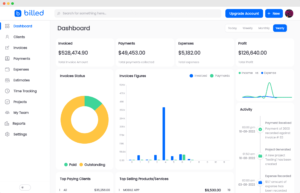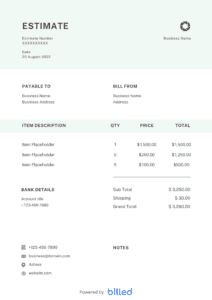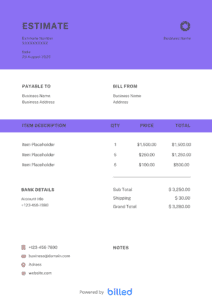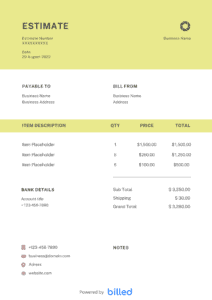Fence Estimate Template

Free Estimate Templates from Billed can save you time and money when creating professional estimates for your fence installation projects.
Get Your Free Fence Estimate Template
Download the free fence estimate template from Billed to create detailed and accurate estimates that reflect your professionalism. You can quickly adapt its format, add your logo, add a personal message, or add fields for tracking and reporting within a few seconds.
Our beautiful and editable fence estimate templates are available in Google Docs, Google Sheets, XLs, Word, and PDF, edit them, and email them to your customers
Download Free Fence Estimate Templates
Estimate With Billed
Send detailed estimates with just a few clicks with Billed.

Estimate With Billed
Create professional-looking estimates in seconds with Billed.

- What is a fence estimate?
- Difference between estimate, invoice, and delivery note
- How do you estimate a fence
- Why Use Our Estimate Templates?
- What is the expiration date of the estimate?
- Fence Estimate making rules
- Tips While Making a Fence Estimate
- How to create a Fence Estimate?
- Some Other Template
- Download The Fence Roof Estimate Template For Free
What is a fence estimate?
A fence estimate calculates the cost and materials required to install or repair a fence for a specific project. It gives clients an idea of the expected expenses and helps contractors plan the job effectively.
Estimate:
An estimate is a document a seller provides to a potential customer before providing goods or services. It outlines the approximate cost of the goods or services the customer wants. The purpose of an estimate is to give the customer an idea of how much they can expect to pay if they proceed with the transaction.
Example: Let’s say you own a painting company and a potential customer contacts you to get an estimate for painting their living room. You visit the customer’s home, assess the room’s size and condition, and based on the required work, provide them with a written estimate that includes the cost of paint, labor, and any additional materials.
Invoice:
After goods or services have been provided, a seller issues an invoice to a buyer. This document formally requests payment and provides a detailed breakdown of the products or services purchased, including their quantities and the total amount due. Invoices typically have payment terms and instructions on how and when the buyer should make the payment.
Example: Following the painting job mentioned in the estimate example, once you have completed the work, you will send an invoice to the customer.
Delivery Note:
A delivery note, a packing slip or delivery receipt is a document used in shipment deliveries to confirm that the delivered goods match what was ordered. It accompanies the goods during transit and is given to the recipient upon delivery. The delivery note includes details such as the items’ description, quantity, and special instructions.
Example: Suppose you run an online bookstore, and a customer orders three books: Books A, B, and C. You pack the books for shipment and include a delivery note in the package.
In summary, an estimate is a document providing a cost estimate before a transaction, an invoice is a request for payment after the transaction, and a delivery note is a document confirming the goods delivered match the order.
How do you estimate a fence?
Estimating the cost of a fence typically involves several factors, including the type of fence, materials used, measurements, labor costs, and any additional features or requirements. Here’s a general outline of the steps involved in estimating a fence:
Determine the purpose and type of fence:
Decide why you need the fence (privacy, security, aesthetics, etc.) and choose the appropriate type (wooden, chain-link, vinyl, etc.).
Measure the perimeter:
Take accurate measurements of the area where the fence will be installed. Measure the length of each side, including any corners or angles.
Decide on fence height and design:
Determine the desired height of the fence based on your needs and local regulations. Choose a fence design that aligns with your preferences and complements the surrounding environment.
Research materials and pricing:
Look for suppliers or retailers that offer the materials you need for the fence. Compare prices for the chosen fence type and material, considering durability, maintenance requirements, and aesthetics.
Calculate materials required:
Using the measurements obtained in step 2, calculate the needed materials, such as fence panels, posts, rails, hardware (screws, nails, etc.), concrete (for post foundations), and any additional accessories like gates or decorative elements.
Labor costs:
Determine if you will be installing the fence yourself or hiring professionals. If hiring, research local fence installation companies and obtain quotes for their labor costs. Remember that labor fees can vary based on location and the complexity of the installation.
Additional costs:
Consider any additional expenses, such as permits or permissions required by local authorities, removal and disposal of old fencing, and potential landscaping adjustments.
Summarize the estimate:
Compile all costs, including materials, labor, and additional expenses, to create a comprehensive estimate for the fence project.
Every client and project has different requirements and budget-levels. To meet all the levels of budgets and requirements, you need to create a quote that fits all your and your client’s needs.
That’s why you need to use accounting software that fulfills all your business needs. Luckily, Billed is a powerful tool that can centrally manage and streamline the business, and SMEs, like sales management, payment management, grasping sales forecasts, cash flow forecasts, as well as creating quotations and invoices.
- Create quotes in bulk
- Automatic calculation
- Alert function to prevent billing omission
- Reduce the psychological stress of paperwork
There is no fixed one. It depends on the product and service. If the price of the material fluctuates, shorten the expiration date. As much as possible, it is better to add the expiration date.
Fence estimating is an essential aspect of planning and executing fencing projects. Accurate fence estimating ensures that suitable materials are acquired, costs are calculated correctly, and the project is completed within budget and timeline constraints, whether for residential, commercial, or industrial purposes. To achieve successful fence estimates, several key rules and considerations come into play, helping fence contractors and project managers navigate the complexities of the estimation process.
Points on Fence Estimating Rules:
Site Assessment:
Before installing a fence, it is important to conduct a comprehensive site assessment. This includes measuring the perimeter, identifying any terrain challenges, and taking note of any obstructions that may affect the installation process. Doing so will ensure that the project requirements are fully understood and that the fence is installed properly..
Material Selection:
Choose appropriate fencing materials based on the project’s purpose, budget, and aesthetic preferences. Different fence types (e.g., wood, vinyl, chain-link, metal) have varying costs and characteristics, so select materials that best suit the client’s needs.
Estimating Quantity:
Accurately calculate the materials needed, such as posts, panels, gates, fasteners, and concrete for securing posts. Overestimating or underestimating can lead to budget overruns or delays.
Labor Costs:
Consider the labor required for fence installation, including excavation, assembly, and any additional tasks like grading the land or removing existing fencing.
Local Regulations:
Understand local zoning laws, building codes, and permit requirements that may impact the fence design and installation. Compliance with regulations is crucial to avoid potential legal issues.
Factor in Gates:
If the project includes gates, account for their size, quantity, and additional hardware needed. Gates add functionality and access points but should be included in the estimate.
Quality vs Cost:
Strike a balance between the quality of materials and overall cost. Higher-quality materials lead to a more durable and aesthetically pleasing fence, which could also increase the initial investment.
Contingency Budget:
Set aside a contingency budget for unforeseen expenses, such as unexpected ground conditions or changes in the project scope. This buffer helps mitigate financial risks during the installation process.
Competitive Pricing:
Research the market and competitors to offer competitive pricing while maintaining profitability. Striking the right balance ensures attracting customers without compromising on service quality.
Clear Communication:
Transparently communicate the estimate to the client, breaking down the costs and detailing the project scope. This fosters trust and minimizes misunderstandings during the fence installation process.
By adhering to these fence estimating rules, contractors and project managers can develop accurate and comprehensive estimates, ensuring successful fencing projects that meet client expectations and industry standards.
Here are some valuable tips to consider while making a fence estimate:
Site Visit and Measurement:
Conduct a thorough site visit to assess the project area and accurately measure the dimensions of the fence line. Note any obstacles, slopes, or irregularities affecting the installation process.
Understand Client Requirements:
Have a detailed discussion with the client to know their specific needs and preferences. Consider the purpose of the fence, desired materials, height, and any additional features like gates or decorative elements.
Research Local Material Costs:
Research the prices of fencing materials in your local area. Prices can vary, so having up-to-date information will ensure your estimate reflects the current market rates.
Break Down Materials and Labor Costs:
Provide a clear breakdown of the materials needed, including posts, panels, concrete, fasteners, gates, etc. Estimate the labor costs involved in the installation process.
Consider Terrain and Ground Conditions:
When calculating labour costs and project timelines, consider any challenging terrain or ground conditions that might require additional work, such as excavation or levelling.
Factor in Delivery and Transportation Costs:
If you need to source materials from outside the project area, include delivery and transportation costs in your estimate.
Check for Local Regulations and Permits:
Be aware of any local regulations and permit requirements for fence installations—factor in the cost and time associated with obtaining necessary permits.
Calculate Waste and Overages:
Consider possible material waste and overages during installation. It’s better to slightly overestimate the materials needed to avoid delays and additional expenses.
Include Miscellaneous Costs:
Account for any miscellaneous expenses like equipment rental, disposal fees, or safety gear that might be necessary for the project.
Provide Clear and Detailed Estimates:
Present the estimate in a clear and itemized format, so the client can easily understand the costs for each fence installation component.
Offer Different Material Options:
If applicable, provide the client multiple material options at various price points. This way, they can make an informed decision based on their budget and preferences.
Set a Realistic Timeline:
Provide an estimated timeline for the project, considering factors like weather conditions and the availability of materials and labor.
Consider Profit Margin:
Ensure that your estimate includes a reasonable profit margin to cover your business expenses and to maintain a sustainable operation.
Keep Communication Open:
Regularly communicate with the client throughout the estimation process to address any questions or concerns they may have.
By following these tips, you can create accurate and comprehensive fence estimates that meet your client’s needs while ensuring a successful and profitable project.
The estimate does not have a specific format. The purpose of the estimate is to consider the transaction conditions and decide whether to accept the order, items, unit prices, quantities, units, and subtotals. Minimum items such as are required.
- Download the Free Fence Estimate Template from Billed
- Date of issue of the estimate
- Contents and quantity of products and services targeted for an estimate
- Unit price and the total amount of products and services targeted for an estimate
- The delivery date of products and services targeted for quotation
- Estimate expiration date
- Submitter’s company name, address, phone number, etc.
- Submitter’s company seal
Download the free fence estimate template from Billed and create detailed and accurate estimates for your projects in seconds.
Once downloaded, you can open the template in Google Sheets, Docs, Word, Excel, and PDF and customize it to meet your specific requirements.







